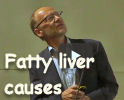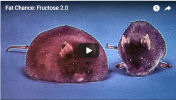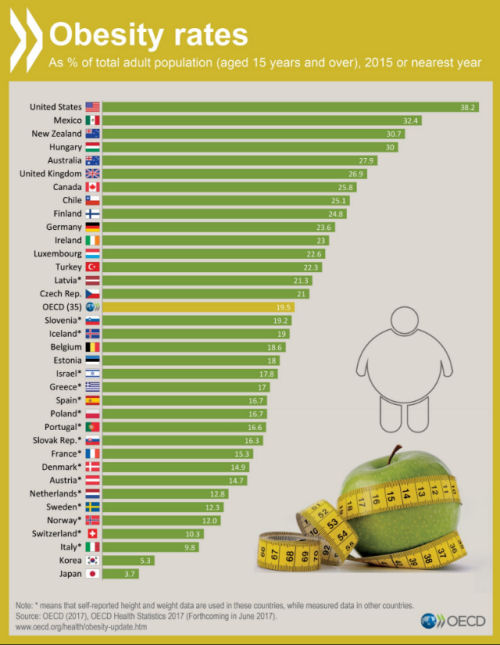Ozempic, obesity, and the modern food trap
 Ozempic is the new "miracle" drug on the market, although it's not a new drug, it's just a successful drug used for diabetes control that has been re-purposed for weight loss.
Ozempic is the new "miracle" drug on the market, although it's not a new drug, it's just a successful drug used for diabetes control that has been re-purposed for weight loss.
 Ozempic is the new "miracle" drug on the market, although it's not a new drug, it's just a successful drug used for diabetes control that has been re-purposed for weight loss.
Ozempic is the new "miracle" drug on the market, although it's not a new drug, it's just a successful drug used for diabetes control that has been re-purposed for weight loss.

 Or should we look at the causes of fatty liver?
Or should we look at the causes of fatty liver?
 This medical research arises from the pandemic problem of fructose in our processed food, which is the major cause of Non-alcoholic fatty liver disease (NAFLD), which accompanies the terrible scale of modern obesity. This hepatitis-related obesity carries high risks of dementia, cirrhosis, and cancer. The effects are similar to those of alcoholism, but awareness of risks is even lower. This study identifies fructose as doing its damage by causing changes to the barrier function of the intestine, which is a new understanding of how the liver-disease starts. The study proposes the idea that a genetic intervention might, at some time in the future, prevent these changes to some degree, in people very seriously affected. It points to genetic interventions in mice made ill by high fructose-induced diets. The authors of the study note that it would, of course, be better not to ingest the fructose. We have also embedded a video about fructose from the U of California.
This medical research arises from the pandemic problem of fructose in our processed food, which is the major cause of Non-alcoholic fatty liver disease (NAFLD), which accompanies the terrible scale of modern obesity. This hepatitis-related obesity carries high risks of dementia, cirrhosis, and cancer. The effects are similar to those of alcoholism, but awareness of risks is even lower. This study identifies fructose as doing its damage by causing changes to the barrier function of the intestine, which is a new understanding of how the liver-disease starts. The study proposes the idea that a genetic intervention might, at some time in the future, prevent these changes to some degree, in people very seriously affected. It points to genetic interventions in mice made ill by high fructose-induced diets. The authors of the study note that it would, of course, be better not to ingest the fructose. We have also embedded a video about fructose from the U of California.
 [Candobetter Ed: NAMES FOR FRUCTOSE: Fructose is a component of sugar (sucrose). The following ingredients all contain fructose: Brown sugar, corn sweetener, corn syrup, dextrose, fructose, glucose, high-fructose corn syrup, honey, lactose, malt syrup, maltose, molasses, raw sugar and sucrose.]
[Candobetter Ed: NAMES FOR FRUCTOSE: Fructose is a component of sugar (sucrose). The following ingredients all contain fructose: Brown sugar, corn sweetener, corn syrup, dextrose, fructose, glucose, high-fructose corn syrup, honey, lactose, malt syrup, maltose, molasses, raw sugar and sucrose.]
A team of international researchers including Monash University academics has discovered that, contrary to previous belief, fructose causes liver toxicity by changing the barrier function of the intestine.
The new study, published today (August 25th) in Nature Metabolism, shows that fructose affects the liver only after it causes intestinal barrier disruption, therefore treatments that prevent barrier disruption could protect the liver from fructose-induced diseases including non-alcoholic fatty liver disease (NAFLD), fibrosis and cancer.
Fructose is a simple sugar which can be found in high quantities in soft drinks, sauces and fast foods. With the advent of modern biochemistry and metabolic analysis, in recent times scientists have discovered that fructose is up to three times more potent than glucose in increasing liver fat.
Excessive fructose consumption has been linked to the recent surge in Nonalcoholic fatty liver disease (NAFLD) - one of the most common metabolic disorders - and its associated co-morbidities, which include liver failure, cirrhosis, and cancer.
Australian metabolic disease expert, Professor Mark Febbraio from Monash’s Institute of Pharmaceutical Sciences, was part of the international team of researchers led by Professor Michael Karin from The University of California San Diego, School of Medicine.
Professor Febbraio says:
“The findings from this study make it clear that fructose does its damage in the intestine and if intestinal barrier deterioration is prevented, the fructose does little harm to the liver.”
The intestine is an organ that makes up part of the gastrointestinal system (more commonly known as the gut). In recent years it’s become evident that excessive fructose metabolism in the gut reduces the production of proteins that maintain the gut barrier, which can lead to a chronic inflammation condition called endotoxemia, as documented in animal studies and paediatric NAFLD patients.
The international team of researchers found that by adding a cell signalling protein called ‘tumor necrosis factor’ (TNF) to hepatocytes stimulates the metabolism of fructose and increases the production of the enzymes that convert the molecule ‘acetyl CoA’ to fatty acids.
“A large increase in the expression of these enzymes was also detected in livers of fructose-fed mice,” says Professor Febbraio. “Conversely, genetic modification that reduced TNF production was found to protect mice from fructose-provoked NAFLD, which is a very exciting step forward for the treatment of diseases which can evolve from this all too common liver disorder.”
Although education and increased awareness are the best solutions to the problem of fructose-induce liver disease, for those individuals who progress to the severe form of NAFLD, known as non-alcoholic steatohepatitis (NASH), the findings described in this study offer some hope of a future therapy based on gut barrier restoration.
This study clearly demonstrates that maintaining gut barrier integrity is a therapeutic target to treat liver disease associated with high fructose consumption.
The researchers will now focus on screening drug candidates that target key proteins in the maintenance of gut barrier integrity.
The full study can be found at: https://www.nature.com/articles/s42255-020-0261-2

 The article by Robert Bridge, quoted and linked to inside, speculates on obesity being a factor in the United States' poor performance in the PyeongChang olympic games. It includes a graph of order of obesity in OECD countries. Australia is the fifth highest obesity country. Japan is the lowest. My money is on high fructose additions to our diets, such as corn-syrup. Dr Lustig University of California San Francisco, Division of Pediatric Endocrinology, has been putting this message out for some time in fascinating scientific videos, including, "Fat Chance" and "The skinny on obesity." I have embedded "Fat chance" in the quoted material from the article inside.
The article by Robert Bridge, quoted and linked to inside, speculates on obesity being a factor in the United States' poor performance in the PyeongChang olympic games. It includes a graph of order of obesity in OECD countries. Australia is the fifth highest obesity country. Japan is the lowest. My money is on high fructose additions to our diets, such as corn-syrup. Dr Lustig University of California San Francisco, Division of Pediatric Endocrinology, has been putting this message out for some time in fascinating scientific videos, including, "Fat Chance" and "The skinny on obesity." I have embedded "Fat chance" in the quoted material from the article inside.

Now that the Olympic torch in PyeongChang has been extinguished and the athletes and fans have gone home, the US is wrestling with its worst performance in 20 years. Could obesity rates be taking a toll on US athletic performance? On the surface, Team USA’s total haul of 23 medals, which included nine golds, seems rather respectable. It put the United States in fourth place, behind Norway, Germany and Canada. But not everyone went home satisfied, and least of all the US Olympic Committee, which had predicted US athletes would win at least 37 medals. Not only were the Americans bested by three countries which, combined, make up just one-third of the US population (Norway, which won 39 gold medals in PyeongChang, has just 5.2 million people), it was their worst performance since the 1998 Nagano Games. The situation looks even more troubling when we consider that the US fielded 242 athletes at PyeongChang, the largest-ever delegation in the history of the Winter Games.
The US has been spending wads of cash in an effort to get the most from its athletes. The amount forked over to Winter sports in the years 2015-16 increased by nearly six percent from the previous Olympic 2011-2012 cycle, AP reported. Alas, all that extra cash has produced little in way of gold. Since the 2010 Vancouver Games, America’s total medal haul in the Winter Games has been on the decline (37, 28 and 23, respectively).
“We have this amazing depth. We have these incredible medalists,” Alan Ashley, US chief of sport performance told reporters following the closing ceremony. He then ventured the question: “How do we continue to compete even at a higher level and give them what they need going forward?”
What is the source of this decline? Since it does not seem related to a lack of funding, or a shortage of potential athletes, could there be particular sociocultural reasons at play, for example particular health factors? As was already acknowledged by the US government back in 2012, when it partnered with Olympic and Paralympic athletes to get more than 1.7 million children involved in sports through Michelle Obama’s "Let's Move!" initiative, obesity is a serious issue that is only getting worse.
A recent study put out by the OECD predicts that by the year 2030, almost 50 percent of Americans will be considered as clinically obese. In 13 states, that number could actually exceed 60 percent.
While there seems to be little research to date on the subject, a 2016 policy paper put out by the American Development Model (ADM) in cooperation with the US Olympics Committee (USOC) suggests that America’s sporting officials are aware of the problem when it warned: “The percentage of obese children ages 6-11 increased from 7 percent in 1980 to 18 percent in 2010. Among children ages 12 to 19, that figure grew from 5 percent to 18 percent.” The paper goes on to detail how parents, schools and sporting clubs can alter their lifestyles and dietary choices to become better athletes.
Read more at https://www.rt.com/op-ed/420669-obesity-usa-olympics-pyeongchang/
Recent comments